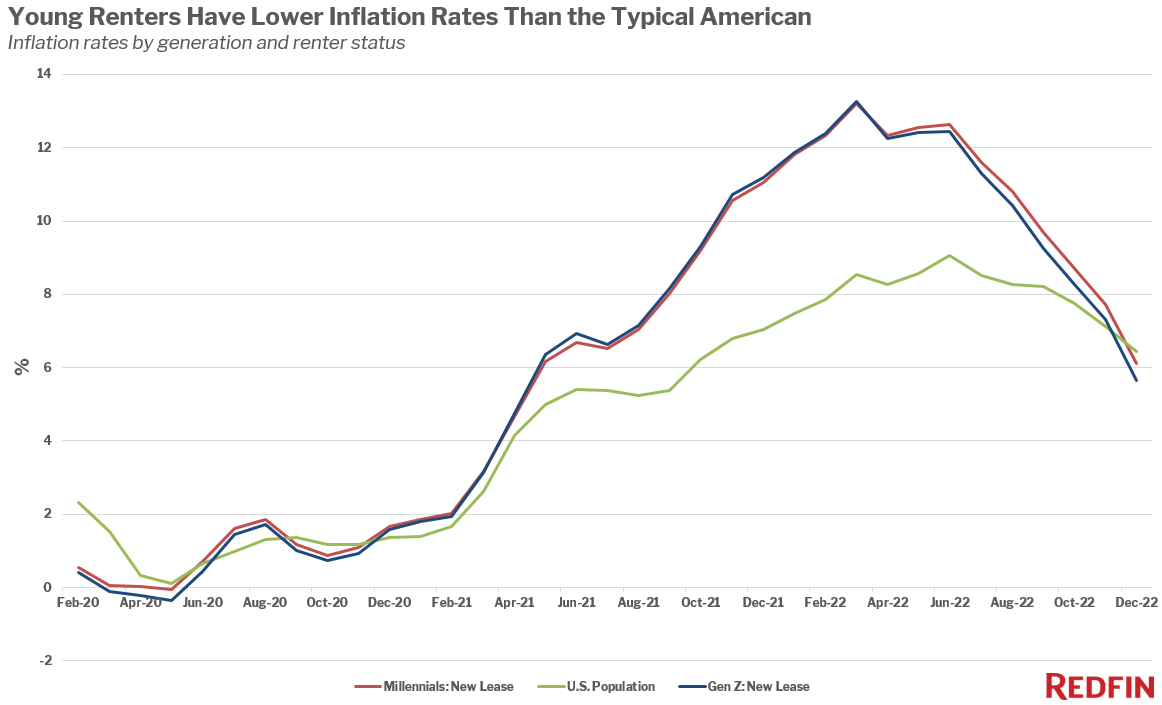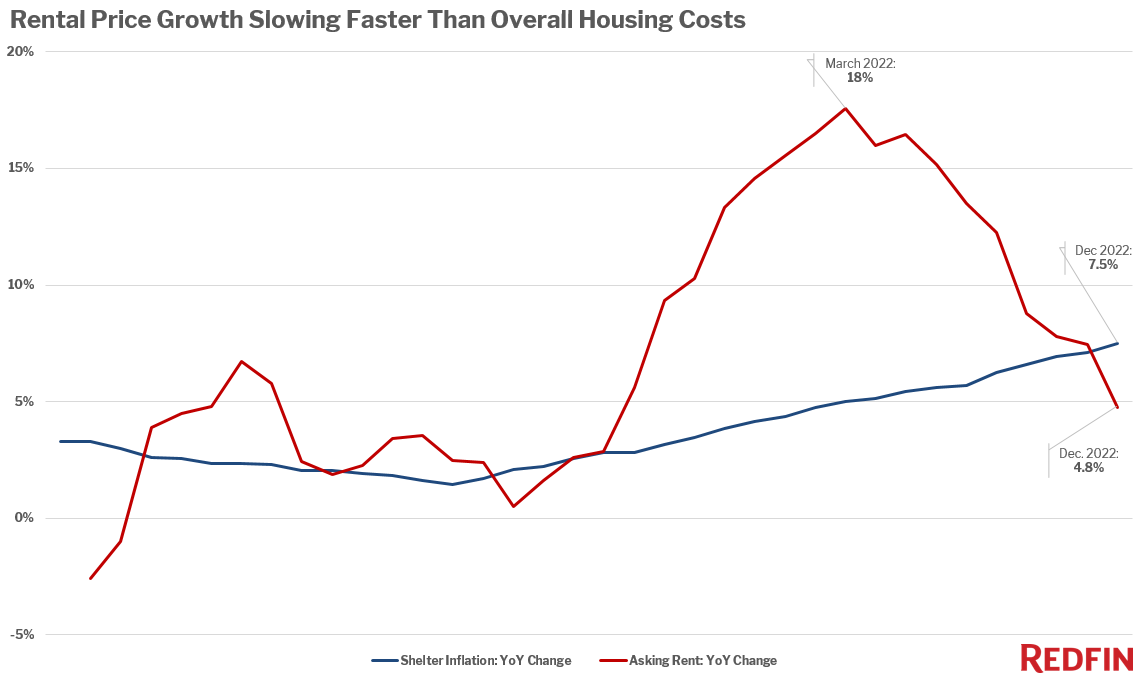Young adults taking on a new lease are getting some relief as rental price growth slows, helping cool their personal inflation rates.
Gen Z and millennial renters have lower personal inflation rates than the overall U.S. population for the first time since the end of 2020. Gen Zers and millennials who signed a new lease in December saw their cost of goods and services increase 5.6% and 6.1%, respectively, compared with a 6.5% increase for the typical American.
That’s a welcome shift for young renters, who saw their personal inflation rates soar last year as rental prices skyrocketed.

This is based on a Redfin analysis of the cost of goods and services for Gen Zers and millennials based on their spending habits, as measured by the U.S. Bureau of Labor Statistics’ Consumer Price Index (CPI). The analysis, which incorporates Redfin’s data on asking-rent prices, weighs each component of inflation–including food, fuel, shelter and other variables–to come up with inflation rates for millennials and Gen Zers who are taking on a new lease. Adult Gen Zers are 18 to 26 years old, and millennials are 27 to 42 years old.
This also marks the first time since the start of 2021 Gen Zers overall have a lower personal inflation rate than the U.S. population, a shift that’s largely due to rental price growth slowing. The personal inflation rate for Gen Zers overall, taking both renters and homeowners into account, came in at 6.4% in December. Millennials, at 6.8%, still have a higher rate than the general population.
Young adults signing a new lease are benefitting from cooling inflation sooner than the typical American. That’s because rents are increasing slower than the overall cost of housing. The median U.S. asking rent for a new lease rose 4.8% year over year in December, the smallest increase in a year and a half and down from 16% last July. That’s compared with overall shelter costs, which rose 7.5%, according to the CPI. Hourly wages for the average U.S. worker rose 4.4% year over year in January.
This is the first time asking rents have posted a smaller increase than the overall cost of housing in a year and a half.

“Shelter” inflation encompasses both rental payments (including existing leases) and the amount homeowners would pay in rent for their own house. That means renters who are locked into yearlong leases, along with homeowners who bought at the peak of the market, will be slower to see cooling inflation reflected in their bank accounts. Shelter inflation hasn’t slowed yet because most people are paying a “shelter” price that’s reflective of last year’s hot rental and housing market, which has since cooled significantly amid elevated mortgage rates. It’s likely to peak soon.
“Ebbing price growth means renters moving now may be getting a better deal than those who signed a new lease in late 2021 or 2022. Asking rents have already dropped from the apex they reached last August and they’ve fallen from a year ago in many parts of the country, including Phoenix, Austin and Los Angeles,” said Redfin Senior Economist Sheharyar Bokhari. “People looking to move now may also want to take advantage of declining demand and negotiate with landlords about perks like free parking or a free month’s rent–and those who are staying put may have some bargaining power when renewing their lease. Rental prices are likely to fall from here nearly everywhere in the country, so it may also be worth waiting a few months if you’re not in a hurry to sign a new lease.”
“For those who are on the fence about continuing to rent or buying their first home, waiting a few months before locking in a new lease could be worthwhile,” Bokhari continued. “If mortgage rates and home prices continue dropping from their peak, entering the housing market will be more affordable than it is today. Depending on individual circumstances, that could shift the math on whether renting or buying makes more financial sense.”
Slowing rent growth has an outsized impact on Gen Zers and millennials because they’re typically the people signing new leases. Just 39% of Americans under 35 years old own their home, and 62% of those aged 35 to 44 own theirs. That’s compared with 70%-plus homeownership rates for Americans 45 and older.
Rental price growth is slowing because of falling demand, with relatively few people moving or planning to move to a new residence. Rental costs that skyrocketed over the last year and a half, along with inflation in other parts of life, makes moving to a new rental unaffordable for many Americans.
Inflation soared in early- to mid-2022 partly because of skyrocketing rental costs and home prices. Shelter inflation makes up about one-third of the value of goods and services included in overall inflation measures.
At the same time, supply is increasing due to an influx of newly built apartments and homeowners who want to hold onto relatively low mortgage rates renting out their properties rather than selling.


